Patients are a priority for hard-flooring makers
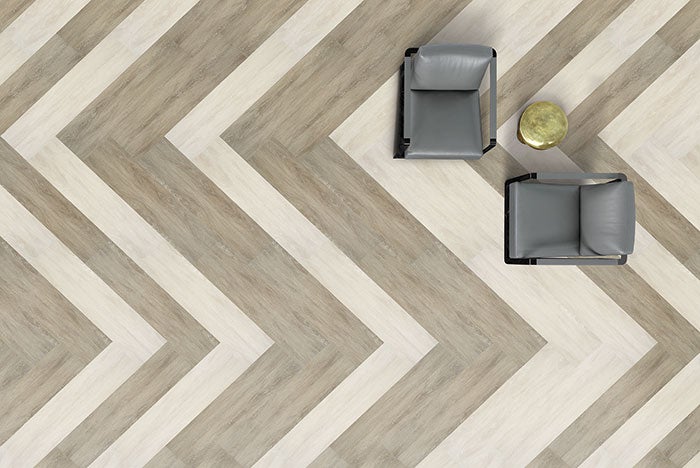
Safety, comfort, acoustics, mobility, ease of maintenance, infection control and aesthetics are all factors that facilities managers should consider when selecting and installing hard flooring in hospitals. They also should look at hard flooring as an interactive surface that can improve health care operations.
“Flooring today is thought of as a solution to the challenges associated with acoustics, patient safety, and the health and well-being of nurses and doctors. The emphasis has shifted from product to people — a shift that better serves the needs of patients and caregivers,” says Mark Huxta, director of sales for health care, Ecore, Lancaster, Pa.
Making smart choices
Smart hard-flooring choices not only can maximize efficiencies through quick installation and easy maintenance, but they also can improve patient satisfaction through noise reduction, cleanliness, and colors and patterns that support a healing environment. To that end, trends include the use of luxury vinyl tile (LVT) in many areas of hospitals; a noninstitutional, homelike look and feel throughout; and easy-to-clean flooring that creates a positive overall experience.
You may also like |
| Creating clean and sustainable facilities |
| Seven aspects of surface selection |
| Materials to aid in infection prevention |
|
|
Low-maintenance, hard-flooring products such as LVT require little water to maintain and do not need harsh chemicals to keep clean. Waxes, strippers and sealers are not required, which results in less water consumption and less contamination of ground water sources.
“We see more use of resilient and hard-surface products in hospitals, although carpet is still used in areas where acoustics and comfort are priorities,” says Ridley Kinsey, director of marketing for health care, retail and multifamily, Patcraft, Dalton, Ga. “LVT is being used in more spaces. Wood-looks still dominate, but there are more requests for non-wood-looks. Key criteria for product selection are maintenance, infection control, mobility, aesthetics and acoustics.”
Kinsey also sees a strong trend to flooring products that do not require finishes to minimize downtime and improve air quality (no stripping, burnishing or waxing). In addition, he sees more subdued-luster products as the industry gains knowledge about problems caused by glare and shiny floors.
Key challenges include understanding all of the technical, performance and cost requirements that meet the flooring needs of hospitals, Kinsey adds. It is important to consider the balance of a design aesthetic with a product that is easy to maintain as well as offer a safe, nonslip surface with ease of mobility and durability. “We define performance by more than how our products withstand the physical demands of an environment, but also how they support human performance, including productivity, health and wellness.”
“Our LVT with squared edges, instead of beveled edges and open embossing, reduces the potential for contamination by debris gathering at the seams,” says Daniel Collins, director of health care markets, Shaw Contract, Cartersville, Ga. “LVT is more rigid than sheet products and can reduce the amount of indentation left behind from heavy machinery and hospital equipment. The construction of the product lends itself to holding higher weights.”
Collins also sees a transition from flooring that mimics wood to other types of looks. Resilient visuals are moving away from traditional wood patterns to more textural and organic visuals that create a calming atmosphere for patients. Ease of maintenance and cleanliness, whether it’s the appearance of being clean or the ease of disinfection, are key for hospital operators, he says.
Because flooring plays an important role in preventing slips and falls, manufacturers are designing safety features into hard flooring. For example, Armstrong Flooring Inc., Lancaster, Pa., designs floors with sufficient traction and optimal walking surfaces, according to Brian Saker, director, commercial product management. “All of our resilient commercial flooring is tested to ASTM D2047 through a rigorous product design safety review. We also offer Safety Zone slip-retardant tile for dry areas that require an extra measure of safety.”
Wayfinding features that help people navigate their way through hospitals are part of new designs as well. Flooring designs can delineate specific areas and guide visitors along the right path, allowing staff to spend more time caring for patients and less on providing directions. “Armstrong Flooring’s broad palette makes it easy to find the right colors, textures and designs to enhance wayfinding in any area of a facility,” Saker notes.
Poured-in-place floors that can withstand challenging, high-traffic conditions are being used in more hospitals today, according to Tom Burns, health care and pharmaceutical market manager, The Stonhard Group, Maple Shade, N.J. This type of flooring offers protection from heavy equipment use and is easy to clean and maintain, he says. Most importantly, poured-in-place flooring assists in infection control because there are no seams or joints where bacteria can hide and grow.
“Poured-in-place flooring is being used more and more in all types of hospital environments, as it eliminates flooring failures due to welds, grout lines and adhesives,” Burns says.
“Stonres RTZ, a poured-in-place, resilient, urethane flooring system, is ergonomic, noise-reducing and offers distinctive design options. It’s recommended for operating rooms because of its ability to support infection control programs and stand up to traffic, impact from surgical implements and harsh chemicals,” Burns notes.
Recent advances in flooring materials for health care facilities include “rigid core” or structural LVT products, floating floors that install quickly, are 100 percent waterproof and have antimicrobial qualities, according to Paul Eanes, vice president of sales, Metroflor Corp., Norwalk, Conn. One example is Metroflor’s Aspecta Ten flooring range. Its design includes large plank-and-tile formats that feature in-register embossing techniques that create an authentic look.
“The need for quick access to flooring areas with minimal downtime during installation requires the use of rapid-setting adhesives or floating floors, products that allow traffic immediately after installation. Aspecta Ten rigid-core flooring provides a solution to this challenge because it is a floating floor that goes down quickly and easily,” Eanes says.
Other introductions
Among the latest hard-flooring introductions to the hospital market, Solitude from Shaw Contract meets safety, acoustics, mobility and aesthetics requirements. It is an easy-to-maintain, wax-optional product that provides a clean appearance with minimal installation effort, according to Collins. A silencing layer reduces noise transmission between floors, while nature-inspired visuals and tones create a calming environment to lessen patient and family stress. Also, Solitude’s 5-mm profile eliminates the need for transition strips, which reduces potential trip hazards and improves patient mobility.
The AdMix collection from Patcraft offers a virtually seamless terrazzolike visual. The solid resin, homogeneous tile is durable (2,500 psi and a lifetime warranty), safe (passes ASTM D2047 for slip-resistance) and designed for high-traffic areas. AdMix seams can be welded, creating a water-resistant surface that is suitable for operating rooms and other clean room environments.
With an eye toward aesthetics, Tarkett North America, Solon, Ohio, recently enhanced its Johnsonite iQ Optima homogeneous sheet and tile flooring. The new iQ Optima draws from the soft, subtle striations found in natural stone or bark with multitonal visuals that add depth, dimension and warmth to a space. “We expanded the collection to include 64 colors, with an updated palette that incorporates softer tones and neutrals that speak to the beauty of natural surroundings,” says Chad Bittner, director of product management and marketing for health care and education.
Tarkett North America also has developed a health care flooring collection that combines the best of its resilient flooring with soft-surface products for public-facing lobbies that can withstand the cleaning requirements of hospitals yet provide a highly designed, comfortable flooring system.
ColorArt Medintone and Medintech homogeneous sheet vinyl with Diamond 10 Technology from Armstrong Flooring are designed for spaces that require infection control. Using cultured diamonds, the floor coating provides high scratch-, stain- and scuff-resistance, and features a full spectrum of colors, tones and patterns, according to Saker.
The company combined the health care facilities performance of Medintech, its commercial offering for 30 years, with its new Diamond 10 Technology coating. “Not only does it provide extreme scratch-, stain- and scuff-resistance, but it allows us to offer a superior no-polish maintenance solution on a homogeneous structure. The Diamond 10 Technology coating allows the material to maintain a newer appearance over a longer period of time,” Saker says.
Building on the success of its “Itstru” technology, Ecore has developed the rx Collection of flooring products. The surfaces feature a performance backing that is fusion-bonded to a heterogeneous vinyl sheet and vulcanized virgin rubber. Later this year, the company plans to introduce an expanded collection of coordinated visuals in this line.
Many hospital facilities professionals are turning to rubber flooring today because it requires no sealants, finishes or other coatings to maintain its original appearance, according to Tim Cole, vice president of marketing, nora systems Inc., Salem, N.H. “Premium rubber flooring can be easily cleaned, in some cases with just water, which means large areas of the hospital need not be closed while floors are stripped, recoated and allowed to dry. Rubber’s dense, nonporous surface repels dirt and stands up to liquid spills without absorbing them. It also provides slip-resistance.”
Rubber is a flexible material that absorbs the pressure of footsteps differently than hard-floor coverings, Cole adds. In doing so, it helps to alleviate the pressure placed on joints and reduces many of the complaints associated with heel pain, plantar fasciitis, shin splints, and knee, hip and lower back pain — complaints that are common among nurses.
Elsewhere, nora systems Inc. offers noraplan lona, which combines the material advantages of premium rubber flooring — from perception of cleanliness and simple maintenance to improved acoustics — with a dense, nonporous surface that helps to repel dirt and bacteria while resisting stains. In addition, the material emits no PVC [polyvinyl choride], plasticizers or halogens, which improves indoor-air quality, Cole says.
Looking ahead
Low-maintenance, hard-flooring products will continue to be of major importance to health care facilities in reducing costs, Saker predicts.
A wide variety of flooring products will proliferate as well. “Thirty years ago, one would see the same type of flooring throughout a hospital,” he says. “Now, a mixture of products is used because the traffic and design needs vary from area to area.”
Neal Lorenzi is a freelance writer based in Mundelein, Ill.

Easy clean
Solitude is an easy-to-maintain, wax-optional product that provides a clean appearance with minimal effort.Shaw Contract
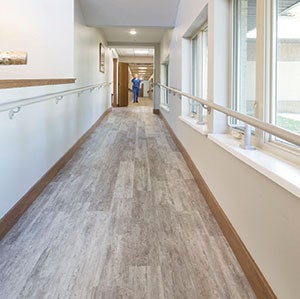
High standard
Aspecta Five flooring provides durability and an upscale aesthetic at this assisted living facility. Metroflor Corp.

Over the rainbow
The iQ Optima Collection includes 64 colors, with an updated palette that incorporates softer tones and neutrals. Tarkett North America
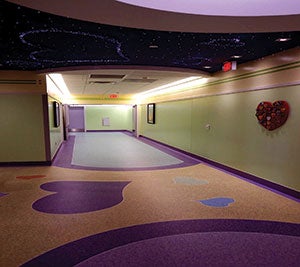
Made to order
Stonres RTZ resilient, urethane flooring offers high durability, stain resistance, noise reduction, and custom color and design. The Stonhard Group
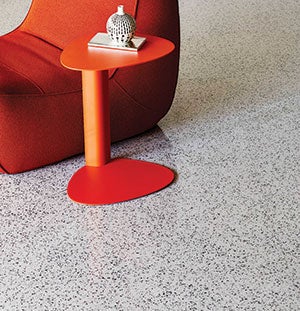
It’s seamless
AdMix seams can be welded, creating a water-resistant surface appropriate for operating rooms and other clean room environments. Patcraft
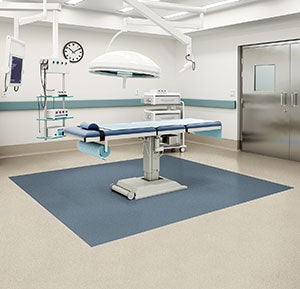
Range of tones
Medintone with Diamond 10 Technology coating withstands heavy traffic, resists staining and comes in soft tonal neutrals and bright colors. Armstrong Flooring Inc.
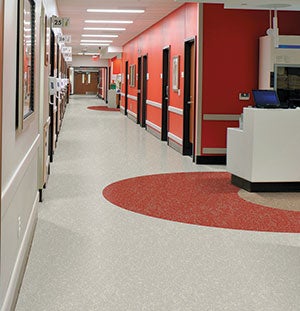
Solid ground
Iona flooring stands up to high-volume traffic in hospitals while providing slip resistance to help prevent falls. nora systems Inc.
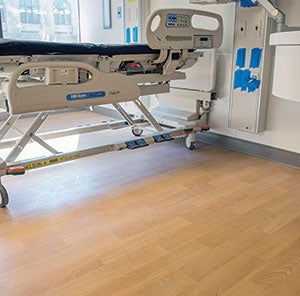
Soft footing
Terrain rx flooring in a hospital installation features performance rubber, fusion-bonded to a contemporary, modern heterogeneous vinyl sheet surface. Ecore




